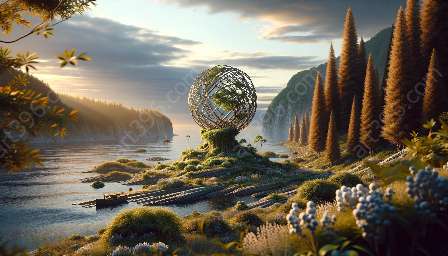Environmental sculpture and sustainable urban development are two interconnected concepts that play a crucial role in shaping modern cities and communities. This article aims to provide a comprehensive exploration of how art, specifically environmental sculpture, contributes to the creation of environmentally friendly urban spaces and promotes sustainable development.
The Role of Environmental Sculpture in Sustainable Urban Development
Environmental sculpture, also known as land art or eco-art, encompasses artworks that are created within or inspired by natural landscapes. These sculptures are often designed to interact with the environment in a harmonious and sustainable manner, blurring the boundaries between art and nature. Through the use of natural materials and site-specific installations, environmental sculptors aim to raise awareness of environmental issues and inspire a sense of connection and stewardship toward the natural world.
Enhancing Urban Aesthetics
One of the key contributions of environmental sculpture to sustainable urban development is its ability to enhance urban aesthetics while minimizing negative impacts on the environment. By integrating sculptural elements into public spaces, cities can create visually engaging environments that encourage people to interact with their surroundings and foster a deeper appreciation for nature.
Promoting Environmental Awareness
Environmental sculptures often convey powerful messages about environmental sustainability, climate change, and ecological preservation. These artworks serve as tangible symbols of environmental consciousness, prompting viewers to reflect on the impact of human activities on the environment and consider alternative, sustainable ways of coexisting with nature.
Integration of Renewable Energy and Green Technology
Some environmental sculptures go beyond aesthetic enhancements and incorporate functional elements that contribute to sustainable urban development. For instance, sculptures may integrate solar panels, kinetic energy generators, or water-harvesting systems, demonstrating practical applications of renewable energy and green technology.
Collaborative Approaches and Community Engagement
Sustainable urban development is a complex and multidimensional process that involves input and collaboration from various stakeholders, including artists, designers, urban planners, and local communities. Environmental sculptors often engage in collaborative projects that bring together diverse expertise to address environmental challenges and revitalize urban spaces through artistic interventions.
Community-Driven Art initiatives
Community-driven environmental sculpture initiatives empower local residents to participate in the co-creation of public artworks that reflect their cultural identity and environmental values. By involving the community in the design and implementation process, these projects help foster a sense of ownership and pride in sustainable urban development efforts.
Urban Regeneration and Green Infrastructure
Strategic placement of environmental sculptures can contribute to urban regeneration efforts by repurposing vacant or underutilized spaces into vibrant, green areas. When integrated with green infrastructure, such as urban parks, greenways, and sustainable transportation systems, environmental sculptures play a vital role in promoting ecological balance and creating resilient urban environments.
Environmental Sculpture as an Educational Tool
Art and education intersect in the realm of environmental sculpture, offering opportunities for experiential learning and environmental literacy. Through curated tours, interactive workshops, and interpretive signage, environmental sculptures become educational instruments that impart valuable knowledge about local ecosystems, biodiversity, and sustainable living practices.
Integration of Art and Science
Environmental sculpture blurs the boundaries between art and science, fostering interdisciplinary collaborations that facilitate the exchange of knowledge between artists, scientists, and environmental professionals. This integrative approach cultivates a deeper understanding of ecological processes and inspires innovative solutions to environmental challenges.
Youth Engagement and Creativity
Engaging young audiences in the appreciation of environmental sculpture fosters creativity and environmental stewardship among future generations. School programs and youth workshops centered on environmental sculpture offer platforms for experiential learning and creative expression, nurturing a sense of environmental responsibility from an early age.
The Future of Environmental Sculpture and Urban Sustainability
The evolving relationship between environmental sculpture and sustainable urban development holds promise for the future of cities worldwide. As environmental concerns continue to shape urban agendas, the integration of art, design, and sustainability principles will play an increasingly pivotal role in shaping resilient, livable, and eco-conscious urban environments.

